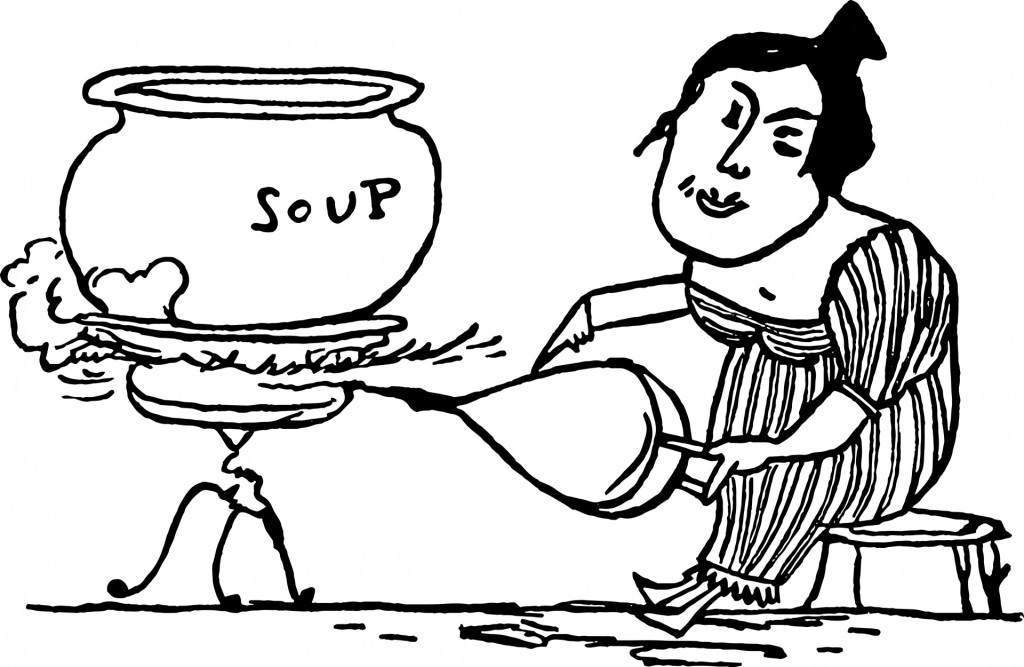In Praise of Broth
November 14, 2016

FROM AN article at the Townsend Newsletter by Allison Siebecker on the importance of broth, which is both medicine and food:
Broth, made from the bones of animals, has been consumed as a source of nourishment for humankind throughout the ages. It is a traditional remedy across cultures for the sick and weak. A classic folk treatment for colds and flu, it has also been used historically for ailments that affect connective tissues such as the gastrointestinal tract, the joints, the skin, the lungs, the muscles and the blood. Broth has fallen out of favor in most households today, probably due to the increased pace of life that has reduced home cooking in general. Far from being old-fashioned, broth (or stock) continues to be a staple in professional and gourmet cuisine, due to its unsurpassed flavor and body. It serves as the base for many recipes including soup, sauces and gravy. Broth is a valuable food and a valuable medicine, much too valuable to be forgotten or discounted in our modern times with our busy ways and jaded attitudes.
[…]
Is broth a food or a medicine? It has traditional use as both. As a food it is generally incorporated into other dishes, serving as a base structure to make soup, stew, sauce or gravy, or to cook grains and beans in, instead of water. Broth is not a complete protein, since it only contains three amino acids. A complete protein needs to contain all 8 essential amino acids. Therefore it is not a meat replacement, but it can be used as a meat extender. Since glycine is used to make other amino acids, it is considered protein sparing. In addition, because glycine is used to make energy in gluconeogenesis, consuming glycine spares your own body protein from being broken down to make energy. Broth is not a meal replacement, which is why it is used as a starting point for soup, or as the first course of a meal.
As a medicine, it is often used alone, sipped at intervals or drunk much like a tea. The word tea, besides referring to the popular beverage, also refers to a form of herbal medicine. “Tea” can be used to describe an infusion or a decoction. To make an infusion, pour boiling water onto herbs, let soak for 5–10 minutes, discard the herbs, and drink the tea. This is how black tea, is made. A decoction differs in that it is made by directly boiling the herbs in water, for 20–40 minutes. This method is used on substances that are tougher, like roots, or bones. Broth is a bone and cartilage decoction, or tea. What this process is doing, with herbs or bones, is removing the active chemical ingredients into the water by means of heat, time, and acid, making the nutrients immediately available to absorb. (Vinegar is also used to remove the minerals from plants when making extractions.)60 Using the standard of herbal formulation, broth qualifies as a medicine.
Being both a food and a medicine, broth has some distinct benefits. In general, food is a form of medicine that has few side effects and is difficult to overdose on. There is less likelihood of forgetting to take the medicine, since eating is a part of a normal daily routine. This is especially true if the medicinal food can be incorporated into established eating patterns, such as using broth to cook grain for a patient who eats grain on a regular basis. Using leftover meat and vegetable scraps to make medicine is a pretty smart form of recycling. It is an example of using the entirety of what Nature provides. Most importantly, broth tastes good, it’s a delicious food that people enjoy eating, and that makes the best medicine.
Broth has another value as well:
Brewing broth fills a home with an aroma of indefinable goodness.
